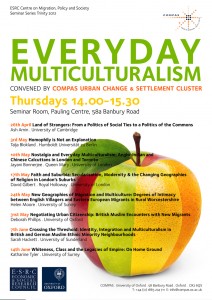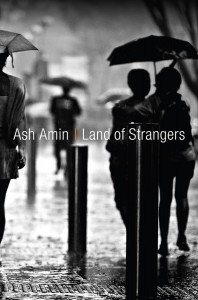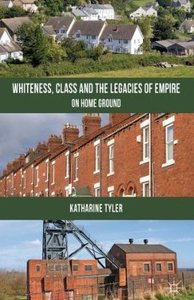Last week, 14th June, we staged the final event of the Trinity 2012 seminar series. The theme of the series was ‘Everyday multiculturalism’, and it was convened by the Urban Change and Settlement cluster. In this blog I aim to summarise and outline some of the main themes presented during the eight seminars.
 To some extent building on the conference on Ethnography, Diversity and Urban Space, staged by COMPAS in September 2011, the aim of the seminar series was to engage with everyday experiences of diversity. Whereas multiculturalism has been steadily ‘downgraded’ on the policy agenda both in the UK and other parts of Europe during the 2000s, social life at neighbourhood level is increasingly characterised by an everyday negotiation of categorical boundaries such as migration histories, religions, migrant statuses, and socio-economic disparities. The aim of the series was to focus on emerging empirical research and methodologies that explored such localised, intercultural processes. Another ambition behind the seminar series was to broaden the geographical scope of our understanding of multiculturalism by presenting research that went beyond the inner-city neighbourhood that often is perceived as the stereotypical place of immigrants and ethnic minorities.
To some extent building on the conference on Ethnography, Diversity and Urban Space, staged by COMPAS in September 2011, the aim of the seminar series was to engage with everyday experiences of diversity. Whereas multiculturalism has been steadily ‘downgraded’ on the policy agenda both in the UK and other parts of Europe during the 2000s, social life at neighbourhood level is increasingly characterised by an everyday negotiation of categorical boundaries such as migration histories, religions, migrant statuses, and socio-economic disparities. The aim of the series was to focus on emerging empirical research and methodologies that explored such localised, intercultural processes. Another ambition behind the seminar series was to broaden the geographical scope of our understanding of multiculturalism by presenting research that went beyond the inner-city neighbourhood that often is perceived as the stereotypical place of immigrants and ethnic minorities.
Enquiries into intergroup relations
 Setting the scene on the basis of his new book, ‘Land of strangers’ (published in April 2012), Ash Amin (Cambridge University) explained how post 9/11 attitudes towards immigrants and minorities have been dominated by fear, surveillance, control and exclusion. Dissenting with a logic of the communal as a field of interpersonal and intercultural ties underwritten by shared historic values, Amin argued for a politics of indifference towards difference as a way forward in order for the convivalities of multiculture in everyday life to become a matrix of community and collective agency, with shared affinities and interests arising out of participation and engagement. In this way, according to Amin, ‘slowly the strange can become familiar and the familiar strange, and collective life a constant negotiation of difference’.
Setting the scene on the basis of his new book, ‘Land of strangers’ (published in April 2012), Ash Amin (Cambridge University) explained how post 9/11 attitudes towards immigrants and minorities have been dominated by fear, surveillance, control and exclusion. Dissenting with a logic of the communal as a field of interpersonal and intercultural ties underwritten by shared historic values, Amin argued for a politics of indifference towards difference as a way forward in order for the convivalities of multiculture in everyday life to become a matrix of community and collective agency, with shared affinities and interests arising out of participation and engagement. In this way, according to Amin, ‘slowly the strange can become familiar and the familiar strange, and collective life a constant negotiation of difference’.
Continuing this enquiry into intergroup relations at the local level, Talja Blokland (Humboldt Universität zu Berlin) explored the notion of homophily, the idea that people tend to flock together with people like themselves. Drawing on interviews in Hillesluis, a working class neighbourhood in Rotterdam, the Netherlands, Blokland argued that too much focus on multiculturalism hampers us from seeing the more general processes of categorization and identification that lie beneath the visible segregation in networks in ethnically and racially diverse contemporary neighbourhoods. Challenging nostalgic narratives that infused neighbourhood and gemeinschaft, Blokland showed how Hillesluis also prior to contemporary settlement patterns had been characterised by strong internal divides. So what people define as ‘like themselves’ or ‘unlike themselves’ is not inherently connected to migration, but rather a general sociological process that takes various forms in various historical moments over time.
Connectivity across communities
A quite different perspective on neighbourhood relations was provided by Jayani Bonnerjee (Queen Mary, University of London). Her talk was based on findings from a research project that explored the idea of ‘connectivity’ within and across transnational and diasporic communities focusing on four key areas: community histories; home, community and migration; cities, communities and connections; and faith communities and religious diasporas. Bonnerjee specifically focused on Anglo Indian and Chinese Calcuttans in London and Toronto. Whereas significant parts of the Anglo Indian and Chinese communities had left Calcutta in the early 1960s, the memories of Calcutta were still very much alive, and the sharing of such memories provided a space for Anglo Indians and Chinese in London and Toronto to meet across ethnic boundaries.
Encounters in different spaces
The two next seminars specifically focused on ‘emerging zones of encounter’. In his talk on ‘Faith and suburbia’, David Gilbert (Royal Holloway)moved into a geographical location, the suburbs, which often are ignored in analyses of diversity and everyday multiculturalism. In addition, as Gilbert argued, religion is often absent in suburban studies which emphasise secularisation and homogeneity. Based on case studies of three different faith groups in North and West London, Gilbert explored three different articulations of the religion and suburban space, which he referred to as ‘semi-detached faith’, ‘edge-city faith’, and ‘ethno-burb faith’. He concluded that the study of faith in suburbia offers new ways of thinking about the complexity of suburban space.
Moving into even more ‘outlandish’ territory, the talk by Helen Moore (University of Surrey) on ‘New geographies of migration and multiculture’ explored the encounter between English villagers and Eastern European migrants in a village in rural Worcestershire. Based on findings from residential, ethnographical fieldwork, More argued that living side-by-side in a state of relative indifference presents an image, from the perspective of the villagers, of successfully integrated ‘unpanicked’ physical relations within the geographically-bounded space of the village. Although a number of villagers and migrants did interact at a variety of levels and in a range of spheres, there remained an inherent power dynamic between the two groups where a boundary was erected between villager/insider/Self and migrant/outsider/Other.
Integration and post-colonialism
Two seminars engaged with aspects of everyday multiculturalism from a Muslim South Asian perspective. Presenting findings from a comparative study of identity and integration processes in Muslim ethnic minority neighbourhoods in Newcastle and the German city of Bremen, the historian Sarah Hackett (University of Sunderland) provided insights from a part of Britain, the north-east, that is usually entirely ignored in research into the dynamics of integration and everyday multiculturalism. In particular focusing on the period 1960-mid 1990s, Hackett identified a general pattern of relatively unproblematic integration in both Bremen and Newcastle. Interestingly, Hackett’s finding that religious identifiers in both Newcastle and Bremen were only of limited significance, in particular pre-2001, contrasted some of the findings emerging from Deborah Phillips 2010 research into the potential for building positive intercultural relations between settled British-Pakistani residents and Eastern European newcomers in 3 inner-city areas of Bradford. The youths interviewed by Phillips would typically identify as British Muslims and express a very strong sense of local belonging, identifying the inner-city areas as a ‘home-space’ that they needed to keep safe ‘for our women’.
 In the final seminar of the series, Katharine Tyler (university of Surrey) spoke on the basis of her new book, ‘Whiteness, Class and the Legacies of Empire: On Home Ground’ (2012). Based on ethnographic fieldwork in three different locations in the Greater Leicester area (a village-like community, a post-industrial town and an inner-city area), Tyler moved the spotlight towards the white majority population, in particular the white middle classes. Mostly absent from analyses of majority-minority relations, Tyler argued that the power and dominance of the white middle classes is rendered invisible within everyday discourses and social practices. What comes to light is a picture of contemporary people’s conceptions of themselves conditioned by the legacy (often unnoticed and forgotten) of a colonial past.
In the final seminar of the series, Katharine Tyler (university of Surrey) spoke on the basis of her new book, ‘Whiteness, Class and the Legacies of Empire: On Home Ground’ (2012). Based on ethnographic fieldwork in three different locations in the Greater Leicester area (a village-like community, a post-industrial town and an inner-city area), Tyler moved the spotlight towards the white majority population, in particular the white middle classes. Mostly absent from analyses of majority-minority relations, Tyler argued that the power and dominance of the white middle classes is rendered invisible within everyday discourses and social practices. What comes to light is a picture of contemporary people’s conceptions of themselves conditioned by the legacy (often unnoticed and forgotten) of a colonial past.
In conclusion, it should be mentioned that this short summary hardly does justice to the richness and depth of the material presented at the seminars. But as all seminars have been audio-recorded, it will be possible to access the podcasts from the COMPAS website in due course.